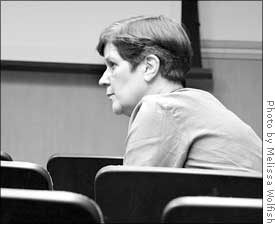
| << Front page | News | April 28, 2006 |
Student Forum with Dye Hits the Hot-Button Issues
Dye Shares Plans in Open Forum
 |
||
| President Gets in Touch: At an open student forum, College President Nancy Dye responds to student questions and concerns in-person with the informality of a conversation. | ||
Oberlin students drifted in and out of Wilder 101 to engage in a conversation with College President Nancy Dye about the concerns they had and what she thought could and should be done about them. Student Senate, as part of a continuing effort to facilitate forums between students and administrators, organized the meeting to help address several hot-button issues that have arisen this semester.
Sustainability was a major issue raised. The discussion of sustainability encompassed future building plans and concerns about the environmental studies department. The environmental studies students present expressed their concern that Oberlin has only three core professors in the department.
Dye responded by noting recent additions to the program such as the new labs in the Gray House next to the Adam Joseph Lewis Center. She said, “We have environmental studies faculty all through the campus. I don’t think there’s any concern right now.”
However, Dye agreed that another environmental studies issue, long waiting lists for core classes that affect even upperclassmen, warranted looking into.
Dye also affirmed that sustainability would play a factor in the new housing projects. It still isn’t clear whether the Board of Trustees will decide to have Oberlin become Leadership in Energy and Environmental Design certified. Oberlin might decide to eschew the actual certification but still build environmentally sustainable equivalents.
“Some say that if we had certified [the Union Street houses] they would have gotten at least a silver [the median of five ratings that range from certified to platinum],” said Dye.
Housing issues led to a discussion of off-campus housing as several students expressed concern over having to live on-campus and on how the recent policy change has affected juniors’ chances for village housing. Dye’s response was consistent with what it has been all semester: ResEd’s policy has always been to fill all the on-campus beds before allowing students off campus.
“We’ve never had as many students off-campus as we have in the last six or seven years,” Dye said. “We’ve had [many more students off-campus before] and that was very hard on the town.”
Dye then directed attention to the new village housing in the works, as well as the planned renovation of the old dorms. The College has hired a new planner to assess all current dorms for sustainability, aesthetics and livability. If deemed unsuitable, some dorms may come down. Dye predicted that East might go, calling it “alienating.”
Students also criticized the new “fearless” marketing strategy at the forum. Students expressed worries that the change signaled an attempt to shift Oberlin’s character and appeal.
Dye said, “This has gotten a whole lot of attention but every time we get new admissions materials, we get a consultant. This was a bigger study but not out of the ballpark. We’ve talked about how to talk about Oberlin and its values in a way that’s easier to understand.”
Addressing the concern of the school’s changing image, Dye said that the College was “particularly interested in [appealing to] African-American students for a number of reasons but also basically anyone who wants to come to Oberlin. I think ‘fearless’ applies to a lot of what Oberlin does and is.”
Supporters of the SPACE Committee asked Dye when students could expect a student-run arts space. Dye first acknowledged that this was a very important, albeit elaborate project, especially considering the number of students interested in arts management. This summer space in the conservation labs will be turned into student studios and student gallery space may be worked into Phase Two building.
Dye identified the area behind the art building and Hall Auditorium as the probable site for what she called an “art district.”
“When you come up to Oberlin you see the backs of those buildings,” said Dye. “An art center would act as an introduction to Oberlin. It would be planned deliberately as an art space along with interesting housing, maybe.”
In the last Senate referendum, students voted overwhelmingly in favor of re-instating the Credit/No-Entry system. When it came up on Wednesday, students praised the system for allowing them to take classes not necessarily in their field of study without punitive grading.
Dye said, “I feel quite strongly that the Credit/No-Entry was a bad system. It’s like credit card debt. It gives very mixed messages to students and it was a really serious factor in suspensions, expulsions and difficulties in graduating on time...It cheapened Oberlin’s transcripts and less people fail under the Pass/No Pass system.”
Responding to questions about the future of the Middle Eastern and North African studies program, Dye said, “We have a committee working on how to get a MENA program together. I believe they’ll turn in a report in a week or so. My guess is that the Khalid Medani position [a Professor who taught Middle Eastern Politics last year] will be refilled. [Visiting art history professor] Yasser Tabbaa might be here...We will see that there is some Arab instruction this year.”
Addressing the equipment problem that arose in Pyle Inn Co-op last week, Dye profusely apologized for not being better informed about the situation but said, “I would be very surprised if [the hood] wasn’t fixed [this summer].”
More issue-specific forums are in the works. A forum on the Credit/No-Entry
system is scheduled for Monday, May 1. Another forum on sustainability at
Oberlin is forthcoming. Discussions on town-college relations and safe spaces
are being saved for next year.
About us
Subscriptions
Advertising